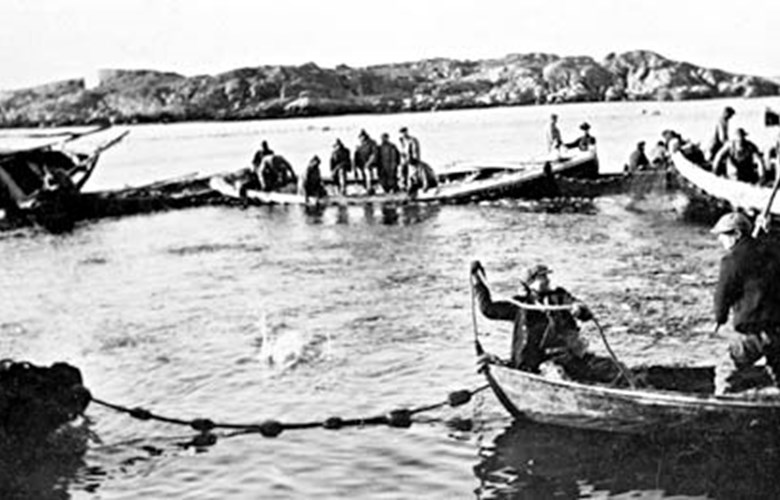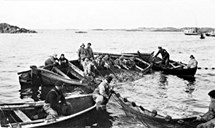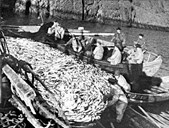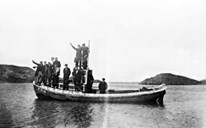Dizzy with optimism
Several people in Solund invested in new seines after the herring approached land one year or two during the First World War. The boat builders in Hardanger had plenty of work making open seine vessels - with modified sterns - for oars or engine, some covered. But only in 1927/28 did the herring come near land fairly regularly. The best years were 1936 and 1944. Nautøy was regarded as a reliable place, but Ospa also, and Gåsvær, and the Kolgrov area were watched closely. A survey shows that fat herring was caught at 65 different places in all in Solund.
Optimism before the start of fishing was usually sky-high. Even the crew, who often came from the fjord country farther to the east, dreamed of easy money.
The legendary big catch
In 1936, herring was closed in over a wide area. They even closed the Rørdalsfjorden, and while they set the seines, the herring pushed at the seines from the outside. So they opened the seines and let still more herring in. They sold 82,000 hectolitres of herring at NOK 3.85 per hectolitre from this catch alone. A diver checked that the seines were tight at the bottom. "We had NOK 1,400 each," Jørgen Trovåg told his friends. At the time a standard residential building could be had for NOK 2-3,000. New, big shore seines changed hands at short notice, one of them long enough to close a whole fjord.
Suitcases with bank notes
In 1944, big catches were made near Kolgrov and Hjønnevåg. Many young people had gone to England, so men were scarce. The herring prices were good, close to NOK 23 per hectolitre. In Solund herring worth more than NOK 4,000,000 was caught with shore seines alone, an enormous sum at the time. The profit was shared at the youth club house at Hardbakke, in bank notes. Master seiners, who received half a million and more, had to carry the money in suitcases and bags. Previous agreements among the crews made many of the crew shares fairly equal. This year even the least well paid man went home with money in his pocket. The municipality of Solund was able to repay all its loans.
The profit comes to an end
Sometimes they could chase a shoal of herring along the shore, with sand, noise, etc., until they were at a good place for a seine to be set. The seine teams depended on cooperation. It was quite common for 2-3 teams to share the catch whoever made it. The weakest party profited by this. But when there were many to share, each got little even in good years.
In between good years, there were bad ones, either because the herring did not arrive, or bad weather made it impossible to set the seines.
Hard to accept
The odour of wet clothes and tobacco smoke rose from narrow boat cabins. The small stove was red hot or ice cold, and not all the smoke went up the chimney. The sanitary conditions were not good, yet the health was good: from pumping boats, clearing snow, rowing, asking news of herring, telling jokes, waiting. Some years that was all, and the seine owner, who was responsible for room and board, had to go to the shed and send the bull off in order to pay for the expenses.
In 1945, they made a big catch near Utvær, but after this the fabulous shore seine fisheries were as good as over. No more herring shoals. It took time for people to accept this, but with time seines and other equipment were sold.




